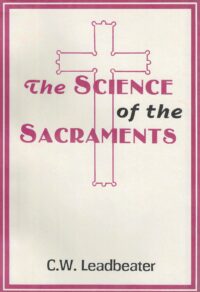The Science of the Sacraments
By Charles Webster Leadbeater (1854 - 1934).
630 Pages | First edition 1920, 11th reprint 1999 | Hardcover | Theosophical Publishing House, Adyar | ISBN: 8170591813.
The Science of Sacraments can be defined as 'a new idea of Church worship', for it presents a clairvoyant description of the inner or invisible side of the traditional Catholic rites. The central theme of the book is that a sacrament is 'an outer and visible sign of an inner, spiritual grace'. The author examines the far-reaching effect of ceremonies like the Holy Eucharist, which benefit not only those attending, but also the community at large with its strong radiance of peace.
The Rt. Revd Charles Webster Leadbeater was acclaimed as one of the great clairvoyants in this century. He wrote many books including The Chakras, Man Visible and Invisible, The Hidden Side of Things and Thought Forms (with Annie Besant). He was for a number of years Presiding Bishop of the Liberal Catholic Church, which seeks to combine the preservation of the Catholic sacraments with the widest measure of freedom of thought and interpretation of the scriptures.
From the Appendix:
" Do not believe in a thing said merely because it is said; nor in traditions because they have been handed down from antiquity; nor in rumours, as such; nor in writings by sages, merely because they have been handed down from antiquity; nor in rumours, as such; nor in writings by sages, merely because sages wrote them; nor in fancies that you may suspect to have been inspired in you by an Angel (that is, in presumed spiritual inspiration); nor in inferences drawn from some haphazard assumption you may have made; nor because of what seems an analogical necessity; nor on the mere authority of your own teachers or masters. But we are to believe when the writing, doctrine or saying is corroborated by our own reason and consciousness. For this I have taught you, not to believe merely because you have heard; but when you believe of your own consciousness, then to act accordingly and abundantly. " - Kalama Sutta of the Anguttara Nikaya.
 Bezig met bijwerken...
Bezig met bijwerken...